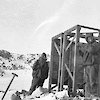The seas and the stars
In their own words
By perseverance and unlimited patience, the tide-gauge down on the harbour-ice was induced to supply a good series of unbroken records.
— Douglas Mawson, Home of the Blizzard
Early in May, not far from the Magnetograph House in the freezing waters of Boat Harbour, the men installed a tide gauge. It incorporated a large vertical pipe containing a float whose rise and fall was recorded directly on to a chart at the top end of the pipe, protruding above the sea ice.
Robert Bage was put in charge of the tide gauge — a task he performed through the dead of winter, when ice and snow frequently required a survey to locate the gauge’s position. The tide gauge continued to function for 98 days, producing the earliest tide records on the East Antarctic coast.
Bage had a further scientific task at Cape Denison — observations of the stars to fix the exact longitude of the base. For this he and a variety of helpers assembled a hut (the Astronomical Hut now known as the Transit Hut) from surplus timbers and in September 1912 erected it near the meteorological screens to the northeast of the Main Hut. Spring sledging duties interrupted his work, but as it turned out he was one of the selected second-year group, and was able to conclude his assigned task in the spring of 1913.
For his tidal and astronomical observations Bage needed an accurate record of time, for which he used a clock in the Main Hut — ‘known and reviled’, as Mawson reported, by light sleepers affected by its ticking. The clock performed badly in low temperatures, and Bage spent a good deal of time trying to keep it going.



